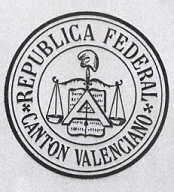
Valencia, natively and officially València, is the capital of the autonomous community of Valencia and the third-most populated municipality in Spain, with 792,492 inhabitants (2022). It is the capital of the province of the same name. The wider urban area comprising the neighbouring municipalities has a population of around 1.6 million, constituting one of the major urban areas on the European side of the Mediterranean Sea. It is located on the banks of the Turia, on the east coast of the Iberian Peninsula at the Gulf of Valencia, north of the Albufera lagoon.

Alzira is a city and municipality of 46,300 inhabitants in Valencia, eastern Spain. It is the capital of the comarca of Ribera Alta in the province of Valencia. The city is the heart of the second largest urban agglomeration in the province, with a population of over 100,000.

Camp de Morvedre is a comarca in the province of Valencia, Valencian Community, Spain.

Tavernes de la Valldigna is a municipality in the Valencian Community, Spain, located in the district of Safor, 54 km far away from Valencia. It is the biggest town in La Valldigna, a horseshoe shape valley bordered by mountains on the west and the Mediterranean Sea to the east. Tavernes gained a City title in December 1916, by King Alfonso XIII. The mayor is Jordi Juan Huguet (2011-). According to the Spanish Statistic National Institute, INE, in 2010 there were 18.130 inhabitants in Tavernes: 9.126 men and 9.004 women.
Moncada is a municipality in the comarca of Horta Nord in the Valencian Community, Spain.
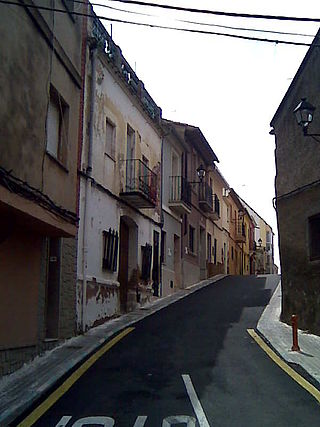
Náquera is a municipality in the region (comarca) of Camp de Túria in the Valencian Community, Spain; placed in the NE of the province of Valencia at a distance of 24 km from Valencia. The main church is Nuestra Señora de la Encarnación.

Quart de Poblet is a municipality in the comarca of Horta Oest in the Valencian Community, Spain. It has 25,499 inhabitants.
The Second Brotherhood was an uprising in the central regions of the Kingdom of Valencia of Habsburg Spain in 1693. The protesters named themselves agermanats after the germanies ("brotherhoods") or guilds of Valencia who had revolted in 1519 in the Revolt of the Brotherhoods, but the two revolts are quite different in their supporters and the social context in which they occurred. Rather than a revolt by middle-class guildsmen, the Second Brotherhood was a peasant revolt against high rents on farmland and crops. Additionally, the Second Brotherhood was resolved far faster and far more peaceably than the violence of the 1519 revolt in both the rebels' actions and the government's subsequent repression.
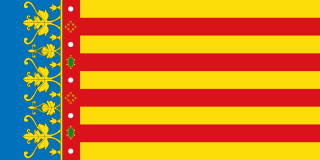
The Valencian Community is an autonomous community of Spain. It is the fourth most populous Spanish autonomous community after Andalusia, Catalonia and the Community of Madrid with more than five million inhabitants. Its homonymous capital Valencia is the third largest city and metropolitan area in Spain. It is located along the Mediterranean coast on the east side of the Iberian Peninsula. It borders Catalonia to the north, Aragon and Castilla–La Mancha to the west, and Murcia to the south, and the Balearic Islands are to its east. The Valencian Community is made up of three provinces: Castelló, Valencia and Alicante.

The Cantonal rebellion was a cantonalist insurrection that took place during the First Spanish Republic between July 1873 and January 1874. Its protagonists were the "intransigent" federal Republicans, who wanted to establish immediately the Federal Republic from the bottom-up without waiting for the Constituent Cortes to draft and approve the new Federal Constitution, as defended by the president of the Executive Power of the Republic Francisco Pi y Margall, a Proudhonian Mutualist supported by the "centrist" and "moderate" sectors of the Federal Democratic Republican Party.

The Route of the Borgias is a cultural route, that includes sites associated with the Borja or Borgia, located in their native Valencian Community, Spain. The marketing of the route was inaugurated in 2007.

The history of Valencia, one of the oldest cities in Spain, begins over 2100 years ago with its founding as a Roman colony under the name "Valentia Edetanorum" on the site of a former Iberian town, by the river Turia in the province of Edetania. The Roman consul Decimus Junius Brutus Callaicus transferred about 2,000 veteran soldiers who had fought under him to Valentia in 138 BC. Valentia lay in a strategic location near the sea on a river island that would later be crossed by the Via Augusta. Pompey razed Valentia to the ground in 75 BC; it was rebuilt about fifty years later with large infrastructure projects, and by the mid-1st century, was experiencing rapid urban growth with many colonists from Italy.

Cueva de Bolomor, or Bolomor Cave, is an archaeological site near Tavernes de la Valldigna in the Valencian Community, Spain. It was occupied over a long period of time, between 350,000 and 120,000 years ago.
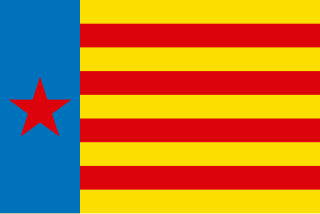
The Popular Executive Committee of Valencia was a revolutionary autonomous entity created on July 22, to confront the Spanish coup of July 1936 which started the Spanish Civil War. It was made up of the political forces of the Popular Front and the trade union forces of the National Confederation of Labor and General Union of Workers. Based in Valencia, it covered most of Valencia province and part of Castellón and Alicante.

The Canton of Cartagena, also known as the Canton of Murcia, was a period of Cartagena, Spain's history when it was governed by a radical cantonalist junta for six months between 1873 and 1874. The city rose up in armed insurrection on July 12, 1873 establishing the Canton's de facto independence from the First Spanish Republic and beginning a wave of cantonal rebellions across southern Spain. Loosely inspired by the more well-known Paris Commune two years earlier, the Canton of Cartagena existed during a turbulent revolutionary period of Spanish history known as the Sexenio Democrático.

The Torres de Quart or Puerta de Quart is one of the two remaining gates of the old Valencia city wall. It was built between 1441 and 1493. It was still in use during the Peninsular War when it was marked by cannonballs and musket shots.
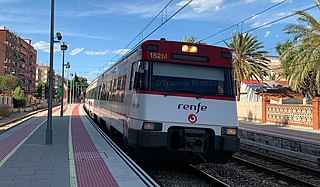
The C-1 line of Cercanías Valencia covers 63 km across the province of Valencia, between Valencia Nord and Gandía or Grao de Gandía. It serves the municipalities of Valencia, Alfafar, Benetússer, Massanassa, Catarroja, Silla, Sollana, Sueca, Cullera, Tavernes de la Valldigna, Xeraco, and Gandia.

The Battle of Chinchilla took place on August 10, 1873, in the context of the Cantonal rebellion, between the Canton of Cartagena and the First Spanish Republic. The result was a heavy defeat for the cantonalists.
